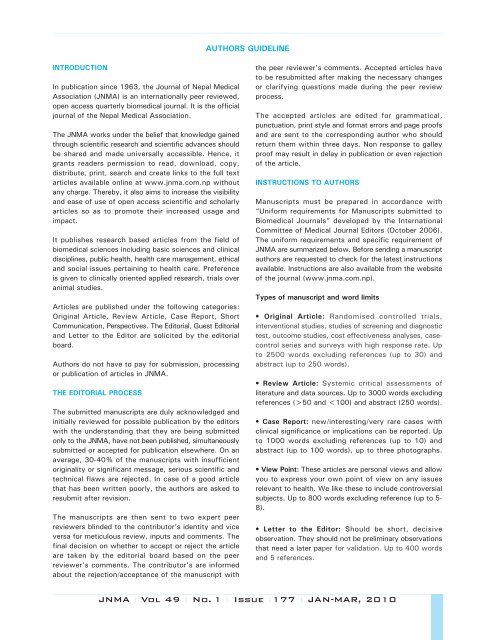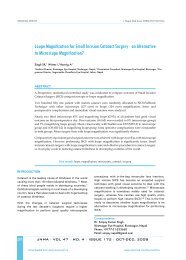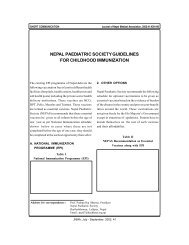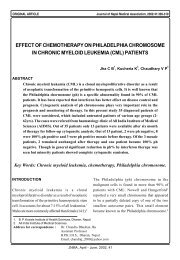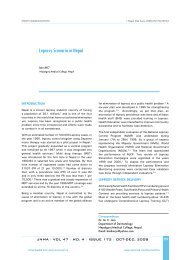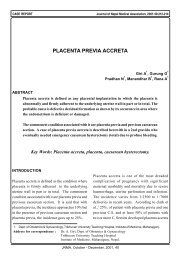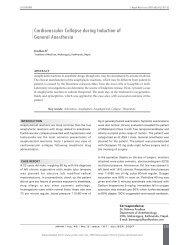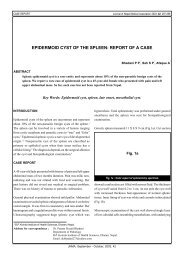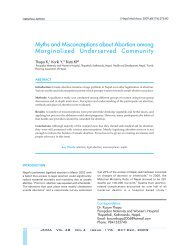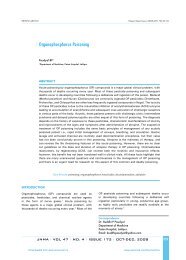jnama 177 final for press.FH11 - Journal of Nepal Medical Association
jnama 177 final for press.FH11 - Journal of Nepal Medical Association
jnama 177 final for press.FH11 - Journal of Nepal Medical Association
Create successful ePaper yourself
Turn your PDF publications into a flip-book with our unique Google optimized e-Paper software.
AUTHORS GUIDELINE<br />
INTRODUCTION<br />
In publication since 1963, the <strong>Journal</strong> <strong>of</strong> <strong>Nepal</strong> <strong>Medical</strong><br />
<strong>Association</strong> (JNMA) is an internationally peer reviewed,<br />
open access quarterly biomedical journal. It is the <strong>of</strong>ficial<br />
journal <strong>of</strong> the <strong>Nepal</strong> <strong>Medical</strong> <strong>Association</strong>.<br />
The JNMA works under the belief that knowledge gained<br />
through scientific research and scientific advances should<br />
be shared and made universally accessible. Hence, it<br />
grants readers permission to read, download, copy,<br />
distribute, print, search and create links to the full text<br />
articles available online at www.jnma.com.np without<br />
any charge. Thereby, it also aims to increase the visibility<br />
and ease <strong>of</strong> use <strong>of</strong> open access scientific and scholarly<br />
articles so as to promote their increased usage and<br />
impact.<br />
It publishes research based articles from the field <strong>of</strong><br />
biomedical sciences including basic sciences and clinical<br />
disciplines, public health, health care management, ethical<br />
and social issues pertaining to health care. Preference<br />
is given to clinically oriented applied research, trials over<br />
animal studies.<br />
Articles are published under the following categories:<br />
Original Article, Review Article, Case Report, Short<br />
Communication, Perspectives. The Editorial, Guest Editorial<br />
and Letter to the Editor are solicited by the editorial<br />
board.<br />
Authors do not have to pay <strong>for</strong> submission, processing<br />
or publication <strong>of</strong> articles in JNMA.<br />
THE EDITORIAL PROCESS<br />
The submitted manuscripts are duly acknowledged and<br />
initially reviewed <strong>for</strong> possible publication by the editors<br />
with the understanding that they are being submitted<br />
only to the JNMA, have not been published, simultaneously<br />
submitted or accepted <strong>for</strong> publication elsewhere. On an<br />
average, 30-40% <strong>of</strong> the manuscripts with insufficient<br />
originality or significant message, serious scientific and<br />
technical flaws are rejected. In case <strong>of</strong> a good article<br />
that has been written poorly, the authors are asked to<br />
resubmit after revision.<br />
The manuscripts are then sent to two expert peer<br />
reviewers blinded to the contributor’s identity and vice<br />
versa <strong>for</strong> meticulous review, inputs and comments. The<br />
<strong>final</strong> decision on whether to accept or reject the article<br />
are taken by the editorial board based on the peer<br />
reviewer’s comments. The contributor’s are in<strong>for</strong>med<br />
about the rejection/acceptance <strong>of</strong> the manuscript with<br />
the peer reviewer’s comments. Accepted articles have<br />
to be resubmitted after making the necessary changes<br />
or clarifying questions made during the peer review<br />
process.<br />
The accepted articles are edited <strong>for</strong> grammatical,<br />
punctuation, print style and <strong>for</strong>mat errors and page pro<strong>of</strong>s<br />
and are sent to the corresponding author who should<br />
return them within three days. Non response to galley<br />
pro<strong>of</strong> may result in delay in publication or even rejection<br />
<strong>of</strong> the article.<br />
INSTRUCTIONS TO AUTHORS<br />
Manuscripts must be prepared in accordance with<br />
“Uni<strong>for</strong>m requirements <strong>for</strong> Manuscripts submitted to<br />
Biomedical <strong>Journal</strong>s” developed by the International<br />
Committee <strong>of</strong> <strong>Medical</strong> <strong>Journal</strong> Editors (October 2006).<br />
The uni<strong>for</strong>m requirements and specific requirement <strong>of</strong><br />
JNMA are summarized below. Be<strong>for</strong>e sending a manuscript<br />
authors are requested to check <strong>for</strong> the latest instructions<br />
available. Instructions are also available from the website<br />
<strong>of</strong> the journal (www.jnma.com.np).<br />
Types <strong>of</strong> manuscript and word limits<br />
• Original Article: Randomised controlled trials,<br />
interventional studies, studies <strong>of</strong> screening and diagnostic<br />
test, outcome studies, cost effectiveness analyses, casecontrol<br />
series and surveys with high response rate. Up<br />
to 2500 words excluding references (up to 30) and<br />
abstract (up to 250 words).<br />
• Review Article: Systemic critical assessments <strong>of</strong><br />
literature and data sources. Up to 3000 words excluding<br />
references (>50 and
Limit <strong>for</strong> number <strong>of</strong> images and tables: <strong>for</strong> all the abovementioned<br />
categories, the number <strong>of</strong> images and tables<br />
should not be more than one per 500 words.<br />
MANUSCRIPT SUBMISSION<br />
Manuscripts must be submitted in clear, concise English.<br />
Please submit: a mandatory electronic copy through<br />
email; three copies <strong>of</strong> the manuscript and original figures;<br />
Forwarding, Authorship and Declaration letters (sample<br />
is available in the JNMA website); a Compact disc (CD)<br />
along with the hard copies. Signed consents must be<br />
given by all authors <strong>for</strong> publication in a letter sent with<br />
the manuscript. The manuscripts should be sent to:<br />
The Editor-in-Chief,<br />
<strong>Journal</strong> <strong>of</strong> <strong>Nepal</strong> <strong>Medical</strong> <strong>Association</strong>,<br />
NMA Building, Siddhi Sadan, P.O. Box 189<br />
Exhibition Road, Kathmandu, <strong>Nepal</strong>.<br />
Email: editor@jnma.com.np<br />
Web: www.jnma.com.np<br />
MANUSCRIPT PREPARATION<br />
All manuscripts should adhere to the JNMA <strong>for</strong>mat. The<br />
manuscript must be typed double-spaced on one side <strong>of</strong><br />
an A4 size white paper with Arial Font (size 12). A<br />
minimum <strong>of</strong> 25 mm margins should be present. The<br />
pages should be numbered consecutively beginning from<br />
the title page. Numbers should be written at the top<br />
right.<br />
INTRODUCTION<br />
Provide a context or background <strong>for</strong> the study (that is,<br />
the nature <strong>of</strong> the problem and its significance). State the<br />
specific purpose or research objective <strong>of</strong>, or hypothesis<br />
tested by, the study or observation; the research objective<br />
is <strong>of</strong>ten more sharply focused when stated as a question.<br />
Both the main and secondary objectives should be clear,<br />
and any prespecified subgroup analyses should be<br />
described. Provide only directly pertinent references, and<br />
do not include data or conclusions from the work being<br />
reported.<br />
METHODS<br />
The Methods section should contain study design, duration<br />
and place <strong>of</strong> study, ethical approval, patient consent<br />
(inclusion and exclusion criteria), sampling, statistical<br />
analysis and s<strong>of</strong>tware used.<br />
This section should only include in<strong>for</strong>mation that was<br />
available at the time the study was planned or protocol<br />
written; all in<strong>for</strong>mation obtained during the conduct <strong>of</strong><br />
the study belongs to the results section.<br />
Selection and Description <strong>of</strong> Participants:<br />
Describe your selection <strong>of</strong> the observational or experimental<br />
participants (patients or laboratory animals, including<br />
controls) clearly, including eligibility and exclusion criteria<br />
and a description <strong>of</strong> the source population. Because the<br />
relevance <strong>of</strong> such variables as age and sex to the object<br />
<strong>of</strong> research is not always clear, authors should explain<br />
their use when they are included in a study report; <strong>for</strong><br />
example, authors should explain why only subjects <strong>of</strong><br />
certain ages were included or why women were excluded.<br />
The guiding principle should be clear about how and why<br />
a study was done in a particular way. When authors use<br />
variables such as race or ethnicity, they should define<br />
how they measured the variables and justify their<br />
relevance.<br />
Technical in<strong>for</strong>mation: Identify the methods, apparatus<br />
(give the manufacturer’s name and address in<br />
parentheses), and procedures in sufficient detail to allow<br />
other workers to reproduce the results. Give references<br />
to established methods, including statistical methods<br />
(see below); provide references and brief descriptions<br />
<strong>for</strong> methods that have been published but are not well<br />
known; describe new or substantially modified methods,<br />
give reasons <strong>for</strong> using them, and evaluate their limitations.<br />
Identify precisely all drugs and chemicals used, including<br />
generic name(s), dose(s), and route(s) <strong>of</strong> administration.<br />
Reports <strong>of</strong> randomized clinical trials should present<br />
in<strong>for</strong>mation on all major study elements, including the<br />
protocol, assignment <strong>of</strong> interventions (methods <strong>of</strong><br />
randomization, concealment <strong>of</strong> allocation to treatment<br />
groups), and the method <strong>of</strong> masking (blinding), based on<br />
the CONSORT Statement (http://www.consort-statement.<br />
org).<br />
Note: Authors submitting review article should include<br />
a section describing the methods used <strong>for</strong> locating,<br />
selecting, extracting, and synthesizing data. These<br />
methods should also be summarized in the abstract<br />
Ethics<br />
When reporting studies on human, indicate whether the<br />
procedures followed were in accordance with the ethical<br />
standards <strong>of</strong> the responsible committee on human<br />
experimentation (institutional or regional) and with the<br />
Helsinki Declaration <strong>of</strong> 1975, as revised in 2000 (available<br />
at http://www.wma.net/e/policy/17-c_e.html). Do not<br />
use patients’ names, initials, or hospital numbers, especially<br />
in illustrative material. When reporting experiments on<br />
animals, indicate whether the institution’s or a national<br />
research council’s guide <strong>for</strong>, or any national law on the<br />
care and use <strong>of</strong> laboratory animals was followed.<br />
JNMA I Vol 49 I No. 1 I Issue I<strong>177</strong> I JAN-MAR, 2010
Evidence <strong>for</strong> approval by a local Ethics Committee (<strong>for</strong><br />
both human as well as animal studies) must be supplied<br />
by the authors on demand. Animal experimental procedures<br />
should be as humane as possible and the details <strong>of</strong><br />
anesthetics and analgesics used should be clearly stated.<br />
The ethical standards <strong>of</strong> experiments must be in<br />
accordance with the guidelines provided by the CPCSEA<br />
(animal) and ICMR (human). The journal will not consider<br />
any paper which is ethically unacceptable. A statement<br />
on ethics committee permission and ethical practices<br />
must be included in all research articles under the ‘Materials<br />
and Methods’ section.<br />
Statistics<br />
Describe statistical methods with enough detaisl to enable<br />
a knowledgeable reader with access to the original data<br />
to verify the reported results. When possible, quantify<br />
findings and present them with appropriate indicators <strong>of</strong><br />
measurement error or uncertainty (such as confi dence<br />
intervals). Avoid relying solely on statistical hypothesis<br />
testing, such as P values, which fail to convey important<br />
in<strong>for</strong>mation about effect size. References <strong>for</strong> the design<br />
<strong>of</strong> the study and statistical methods should be to standard<br />
works when possible (with pages stated). Defi ne statistical<br />
terms, abbreviations, and most symbols. Specify the<br />
computer s<strong>of</strong>tware used.<br />
RESULTS<br />
Present your results in logical sequence in the text, tables,<br />
and illustrations, giving the main or most important fi<br />
ndings first. Do not repeat all the data in the tables or<br />
illustrations in the text; emphasize or summarize only<br />
the most important observations. Extra or supplementary<br />
materials and technical detail can be placed in an appendix<br />
where they will be accessible but will not interrupt the<br />
flow <strong>of</strong> the text, or they can be published solely in the<br />
electronic version <strong>of</strong> the journal.<br />
When data are summarized in the Results section, give<br />
numeric results not only as derivatives (<strong>for</strong> example,<br />
percentages) but also as the absolute numbers from<br />
which the derivatives were calculated, and specify the<br />
statistical methods used to analyze them. Restrict tables<br />
and figures to those needed to explain the argument <strong>of</strong><br />
the paper and to assess supporting data. Use graphs as<br />
an alternative to tables with many entries; do not duplicate<br />
data in graphs and tables. Avoid nontechnical uses <strong>of</strong><br />
technical terms in statistics, such as “random” (which<br />
implies a randomizing device), “normal,” “signifi cant,”<br />
“correlations,” and “sample.”<br />
Where scientifically appropriate, analyses <strong>of</strong> the data by<br />
such variables as age and sex should be included.<br />
DISCUSSION<br />
Emphasize the new and important aspects <strong>of</strong> the study<br />
and the conclusions that follow from them. Do not repeat<br />
in detail data or other in<strong>for</strong>mation given in the Introduction<br />
or the Results section. For experimental studies, it is<br />
useful to begin the discussion by summarizing briefly the<br />
main findings, then explore possible mechanisms or<br />
explanations <strong>for</strong> these findings, compare and contrast<br />
the results with other relevant studies, state the limitations<br />
<strong>of</strong> the study, and explore the implications <strong>of</strong> the fi ndings<br />
<strong>for</strong> future research and <strong>for</strong> clinical practice.<br />
CONCLUSIONS<br />
Link the conclusions with the goals <strong>of</strong> the study but<br />
avoid unqualified statements and conclusions not<br />
adequately supported by the data. In particular, avoid<br />
making statements on economic benefits and costs unless<br />
the manuscript includes the appropriate economic data<br />
and analyses. Avoid claiming priority or alluding to work<br />
that has not been completed. State new hypotheses<br />
when warranted, but label them clearly as such.<br />
REFERENCES<br />
We use Citing Medicine, The US National Library <strong>of</strong><br />
Medicine (NLM) Style Guide <strong>for</strong> Authors, Editors, and<br />
Publishers <strong>for</strong> references. It should be numbered<br />
consecutively in the order in which they are first mentioned<br />
in the text (not in alphabetic order). Identify references<br />
in text, tables, and legends by Arabic numerals in<br />
superscript with after the punctuation marks. References<br />
cited only in tables or figure legends should be numbered<br />
in accordance with the sequence established by the fi<br />
rst identification in the text <strong>of</strong> the particular table or<br />
JNMA I Vol 49 I No. 1 I Issue I<strong>177</strong> I JAN-MAR, 2010
figure. Use the style <strong>of</strong> the examples below, which are<br />
based on the Citation Medicine <strong>for</strong>mats used by the NLM<br />
<strong>for</strong>m MEDLINE/PubMed database. The titles <strong>of</strong> journals<br />
should be abbreviated according to the style available in<br />
MEDLINE/PubMed database. Use complete name <strong>of</strong> the<br />
journal <strong>for</strong> non-indexed journals. Avoid using abstracts<br />
as references. In<strong>for</strong>mation from manuscripts submitted<br />
but not accepted should be cited in the text as<br />
“unpublished observations” with written permission from<br />
the source. Avoid citing a “personal communication”<br />
unless it provides essential in<strong>for</strong>mation not available from<br />
a public source, in which case the name <strong>of</strong> the person<br />
and date <strong>of</strong> communication should be cited in parentheses<br />
in the text. Include the last names and initials <strong>of</strong> the<br />
authors, title <strong>of</strong> article, name <strong>of</strong> publications, year<br />
published, volume number, and inclusive pages. The style<br />
and punctuation <strong>of</strong> the references should con<strong>for</strong>m to the<br />
following examples.<br />
<strong>Journal</strong><br />
Adhikari S, Badhu BP, Bhatta NK, Jha CB, Kumari N.<br />
Etiology and Clinical Pr<strong>of</strong>ile <strong>of</strong> Pediatric Cataract in a<br />
Tertiary Care Center <strong>of</strong> Eastern <strong>Nepal</strong>. J <strong>Nepal</strong> Med<br />
Assoc. 2007;46(167):94-8. Shrestha BM, Halor JL.<br />
Factors Infl uencing Long-term Outcomes following Renal<br />
Transplantatio: A Review. J <strong>Nepal</strong> Med Assoc.<br />
2007;46(167):136-42.<br />
Book<br />
Magar A, Shrestha RK, Palikhey S, Shrestha S, Dhakal<br />
A. Angel’s Concise Clinical Methods. Kathmandu: Makalu<br />
Publication; 2006.<br />
Shapiro BM. Awaking <strong>of</strong> the invertebrate egg at<br />
fertilization. In: Mastoianni L, Biggers JD, eds. Fertilization<br />
and embryonic development in vitro: New York; Plenum<br />
Press: 1981. p. 232-55.<br />
The commonly cited types <strong>of</strong> references are shown here,<br />
<strong>for</strong> other types <strong>of</strong> references such as electronic media;<br />
newspaper items, etc. please refer to ICMJE Guidelines<br />
(http://www.icmje.org or http://www.nlm.nih.gov/bsd/<br />
uni<strong>for</strong>m_requirements.html or http://www.ncbi.nlm.nih.<br />
gov/books/bookres.fcgi/citmed/frontpage.html).<br />
Tables<br />
Tables should be self-explanatory and should not duplicate<br />
textual material. Tables with more than 10 columns and<br />
25 rows are not acceptable. Number tables, in Arabic<br />
numerals, consecutively in the order <strong>of</strong> their first citation<br />
in the text and supply a brief title <strong>for</strong> each. Type or print<br />
each table with double spacing on a separate sheet <strong>of</strong><br />
paper. Do not use internal horizontal or vertical lines.<br />
Give each column a short or an abbreviated heading.<br />
Authors should place explanatory matter in footnotes,<br />
not in the heading. Explain all nonstandard abbreviations<br />
in footnotes, and use the following symbols, in sequence:<br />
*, †, ‡, §, ||, , **, ††, ‡‡<br />
Identify statistical measures <strong>of</strong> variations, such as standard<br />
deviation and standard error <strong>of</strong> the mean.<br />
Be sure that each table is cited in the text.<br />
If you use data from another published or unpublished<br />
source, obtain permission and acknowledge that source<br />
fully. Submit such tables <strong>for</strong> consideration with the paper<br />
so that they will be available to the peer reviewers.<br />
Figures (Illustrations)<br />
Graphs, charts, diagrams or pen drawings must be drawn<br />
by pr<strong>of</strong>essional hands in Indian ink (black) on white<br />
drawing paper. In case <strong>of</strong> x-ray, miniature photo prints<br />
should be supplied. Photographs should be supplied in<br />
high quality glossy paper not smaller than 203 mm x<br />
254 mm (8” x 10”). In case <strong>of</strong> microphotographs, stains<br />
used and magnifi cation should be mentioned. Each<br />
illustration should bear on its back the figure number and<br />
an arrow indicating the top. All illustrations should be<br />
black and white and should be submitted in triplicate<br />
with suitable legends. We accept electronic versions <strong>of</strong><br />
illustrations, which should have a resolution <strong>of</strong> 300 dpi,<br />
and the dimension <strong>of</strong> 640 x 480 to 800 x 600 pixels<br />
and picture <strong>for</strong>mat should be JPEG (*.jpg, *.jpeg) or TIFF<br />
(*.tif, *.tiff). Pictures will be published in B/W free <strong>of</strong><br />
charge. But, if you want to publish your picture in color,<br />
please contact the editorial board <strong>for</strong> the cost and payment<br />
procedure.<br />
For x-ray films, scans, and other diagnostic images, as<br />
well as pictures <strong>of</strong> pathology specimens or<br />
photomicrographs, send sharp, glossy, black-and-white<br />
or color photographic prints, usually 127x173 mm (5x7<br />
inches). Letters, numbers, and symbols on figures should<br />
there<strong>for</strong>e be clear and consistent throughout and large<br />
enough to remain legible when the figure is reduced <strong>for</strong><br />
publication.<br />
Photomicrographs should have internal scale markers.<br />
Symbols, arrows, or letters used in photomicrographs<br />
should contrast with the background.<br />
Photographs <strong>of</strong> potentially identifiable people must be<br />
accompanied by written permission to use the photograph.<br />
Figures should be numbered consecutively according to<br />
the order in which they have been cited in the text. If<br />
a figure has been published previously, acknowledge the<br />
JNMA I Vol 49 I No. 1 I Issue I<strong>177</strong> I JAN-MAR, 2010
original source and submit written permission from the<br />
copyright holder to reproduce the figure. Permission is<br />
required irrespective <strong>of</strong> authorship or publisher except<br />
<strong>for</strong> documents in the public domain.<br />
Legends <strong>for</strong> Figures (Illustrations)<br />
Type or print out legends <strong>for</strong> illustrations using double<br />
spacing, starting on a separate page, with Arabic numerals<br />
corresponding to the illustrations. When symbols, arrows,<br />
numbers, or letters are used to identify parts <strong>of</strong> the<br />
illustrations, identify and explain each one clearly in the<br />
legend. Explain the internal scale and identify the method<br />
<strong>of</strong> staining in photomicrographs.<br />
Units <strong>of</strong> Measurement<br />
Measurements <strong>of</strong> length, height, weight, and volume<br />
should be reported in metric units (meter, kilogram, or<br />
liter) or their decimal multiples.<br />
Temperatures should be in degrees Celsius. Blood<br />
<strong>press</strong>ures should be in millimeters <strong>of</strong> mercury, unless<br />
other units are specifically required by the journal.<br />
Authors must report laboratory in<strong>for</strong>mation in both local<br />
and International System <strong>of</strong> Units (SI). Editors may request<br />
that authors add alternative or non-SI units, since SI<br />
units are not universally used. Drug concentrations may<br />
be reported in either SI or mass units, but the alternative<br />
should be provided in parentheses where appropriate.<br />
Abbreviations and Symbols<br />
Use only standard abbreviations; use <strong>of</strong> nonstandard<br />
abbreviations can be confusing to readers. Avoid<br />
abbreviations in the title <strong>of</strong> the manuscript. The spelledout<br />
abbreviation followed by the abbreviation in parenthesis<br />
should be used on first mention unless the abbreviation<br />
is a standard unit <strong>of</strong> measurement.<br />
Copyright Transfer and Author Agreement<br />
Submission <strong>of</strong> the manuscript means that the authors<br />
agree to assign exclusive copyright to JNMA. All authors<br />
must sign a Copyright Transfer and Author Agreement<br />
<strong>for</strong>m upon submission <strong>of</strong> the manuscript to the <strong>Journal</strong>.<br />
The work shall not be published elsewhere in any language<br />
without the written consent <strong>of</strong> JNMA. The articles<br />
published in this journal are protected by copyright which<br />
covers translation rights and the exclusive rights to<br />
reproduce and distribute all <strong>of</strong> the articles printed in the<br />
journal.<br />
Authorship:<br />
All persons designated as authors should qualify <strong>for</strong><br />
authorship. Authorship credit should be based only on<br />
significant contribution. The first author named must<br />
accept the responsibility <strong>for</strong> ensuring that both versions<br />
<strong>of</strong> the paper submitted and the corrected pro<strong>of</strong>s have<br />
the approval <strong>of</strong> all co-authors. Submission <strong>of</strong> a manuscript<br />
will also be taken to imply that all authors have obtained<br />
permission from their employers or institution to publish,<br />
if they are obliged to do so and that relevant ethical<br />
approval has been obtained <strong>for</strong> clinical studies. However,<br />
authorship credit should be based only on significant<br />
contribution to (a) conception and design, or analysis<br />
and interpretation <strong>of</strong> data, to (b) drafting the article or<br />
revising it critically <strong>for</strong> important intellectual content and<br />
on (c) <strong>final</strong> approval <strong>of</strong> the version to be published.<br />
Authors may include explanation <strong>of</strong> each author’s<br />
contribution separately.<br />
Dual publication:<br />
If material in a submitted article has been published<br />
previously or is to appear in part or whole in another<br />
publication, the Chief Editor must be in<strong>for</strong>med. If the<br />
same paper appears simultaneously elsewhere or has<br />
previously been published or appears in a future<br />
publication, then the author will be black-listed <strong>for</strong> the<br />
JNMA and future articles <strong>of</strong> the author will be rejected<br />
automatically.<br />
Forwarding letter:<br />
The covering letter accompanying the article should<br />
contain the name and complete postal address <strong>of</strong> one<br />
author as correspondent and must be signed by all<br />
authors. The correspondent author should notify change<br />
<strong>of</strong> address, if any, on time.<br />
Declaration:<br />
A declaration letter should be submitted stating that the<br />
manuscript represents valid work and that neither this<br />
manuscript nor one with substantially similar content<br />
under the present authorship has been published or is<br />
being considered <strong>for</strong> publication elsewhere and the<br />
authorship <strong>of</strong> this article will not be contested by anyone<br />
whose name(s) is/are not listed here, and that the order<br />
<strong>of</strong> authorship as placed in the manuscript is <strong>final</strong> and<br />
accepted by the co-authors. Declarations should be<br />
signed by all the authors in the order in which they are<br />
mentioned in the original manuscript.<br />
41<br />
JNMA I Vol 49 I No. 1 I Issue I<strong>177</strong> I JAN-MAR, 2010
Electronic version <strong>of</strong> manuscripts<br />
Do not use ‘oh’ (O) <strong>for</strong> ‘zero’ (0), ‘el’ (l) <strong>for</strong> one (1). Do<br />
not use space bar <strong>for</strong> indentation. Do not break words<br />
at the end <strong>of</strong> lines. Do not insert a tab, indent, or extra<br />
spaces be<strong>for</strong>e beginning <strong>of</strong> a paragraph. Do not use<br />
s<strong>of</strong>tware’s facility <strong>of</strong> automatic referencing, footnotes,<br />
headers, footers, etc.<br />
Sending a revised manuscript<br />
While submitting a revised manuscript, contributors are<br />
requested to include, along with single copy <strong>of</strong> the fi nal<br />
revised manuscript, a photocopy <strong>of</strong> the revised manuscript<br />
with the changes underlined in red and with the point to<br />
point clarification to each comment. The manuscript<br />
number should be written on each <strong>of</strong> these documents.<br />
If the manuscript is submitted online, the contributors’<br />
<strong>for</strong>m and copyright transfer <strong>for</strong>m has to be submitted in<br />
original with the signatures <strong>of</strong> all the contributors within<br />
two weeks from submission. Hard copies <strong>of</strong> the images,<br />
<strong>for</strong> articles submitted online, should be sent to the journal<br />
<strong>of</strong>fice at the time <strong>of</strong> submission <strong>of</strong> a revised manuscript.<br />
CHECK LIST<br />
While submitting your manuscript to JNMA please make<br />
sure you have submitted following documents:<br />
1 Forwarding Letter<br />
2 Authorship<br />
3 Declaration<br />
4 Manuscript<br />
Forwarding letter<br />
• Signed by all contributors<br />
• Previous publication / presentations mentioned<br />
• Source <strong>of</strong> funding mentioned<br />
• Conflicts <strong>of</strong> interest disclosed<br />
Authors<br />
• Complete author in<strong>for</strong>mation<br />
• Author <strong>for</strong> correspondence, with e-mail and telephone<br />
numbers<br />
• Identity not revealed in paper except title page (e.g.<br />
name <strong>of</strong> the institute in material and methods, citing<br />
previous study as ‘our study’, names on fi gure labels,<br />
name <strong>of</strong> institute in photographs, etc.<br />
Presentation and <strong>for</strong>mat<br />
• Manuscript with double spacing<br />
• Margins 2.5 cm from all four sides<br />
• Title page contains all the desired in<strong>for</strong>mation (vide<br />
supra)<br />
• Running title (not more than 50 characters)<br />
• Abstract page contains the full title <strong>of</strong> the manuscript<br />
• Abstract provided (not more than 150 words <strong>for</strong> case<br />
reports and 250 words <strong>for</strong> original articles)<br />
• Structured abstract provided <strong>for</strong> an original article<br />
• Key words provided (three or more)<br />
• Introduction <strong>of</strong> 75-100 words<br />
• Heading in title case (not ALL CAPITALS, not underlined)<br />
• References cited in superscript in the text without<br />
brackets<br />
• References according to the journal's instruction.<br />
Table and figures<br />
• Number within specified limits.<br />
• No repetition <strong>of</strong> data in tables/graphs and in text<br />
• Actual numbers from which graphs drawn, provided<br />
• Figures necessary and <strong>of</strong> good quality (color)<br />
• Table and figure numbers in Arabic letters (not Roman)<br />
• Labels pasted on back <strong>of</strong> the photographs (no names<br />
written )<br />
• Figure legends provided (not more than 40 words)<br />
• Patients' privacy maintained (if not, written permission<br />
enclosed)<br />
• Credit note <strong>for</strong> borrowed figures/tables provided<br />
• Manuscript provided on a CD (with single spacing)<br />
Grammar<br />
• Use correct grammar, punctuation and word synthesis<br />
• Abbreviations spelt out in full <strong>for</strong> the first time<br />
• Spell out-single-digit numbers (1-9) except when<br />
beginning a sentence and use numerals <strong>for</strong> all others<br />
• Numerals at the beginning <strong>of</strong> the sentence spelt out<br />
JNMA I Vol 49 I No. 1 I Issue I<strong>177</strong> I JAN-MAR, 2010<br />
42


